5.11.2019
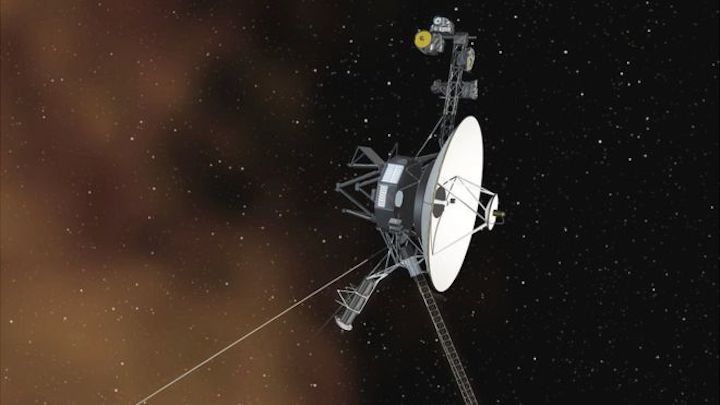
Data sent back by the two Voyager spacecraft have shed new light on the structure of the Solar System.
Forty-two years after they were launched, the spacecraft are still going strong and exploring the outer reaches of our cosmic neighbourhood.
By analysing data sent back by the probes, scientists have worked out the shape of the vast magnetic bubble that surrounds the Sun.
The two spacecraft are now more than 10 billion miles from Earth.
Researchers detail their findings in six separate studies published in the journal Nature Astronomy.
"We had no good quantitative idea how big this bubble is that the Sun creates around itself with its solar wind - ionised plasma that's speeding away from the Sun radially in all directions," said Ed Stone, the longstanding project scientist for the missions.
"We certainly didn't know that the spacecraft could live long enough to reach the edge and leave the bubble to enter interstellar space."
The plasma consists of charged particles and gas that permeate space on both sides of the magnetic bubble, known as the heliosphere.
Measurements show that the identical probes have exited the heliosphere and entered interstellar space - the region between stars. Voyager 1 entered interstellar space in 2012, Voyager 2 crossed over late last year. The key sign in both cases was a jump in the density of plasma.
This showed that the spacecraft were passing from an environment with hot, lower density plasma characteristic of the solar wind and entering a region with the cool, higher density plasma thought to be found in interstellar space.
The boundary between the two regions is known as the heliopause.
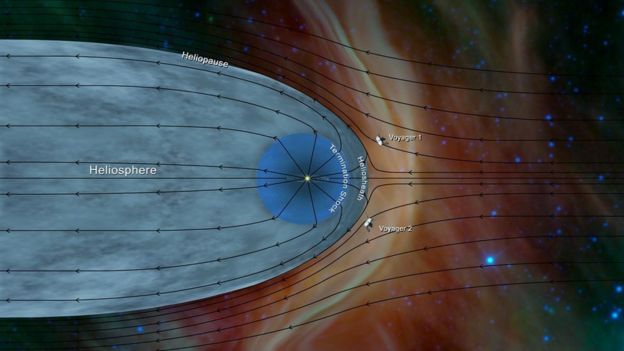 Image copyrightNASA JPL
Image copyrightNASA JPL
"We saw the plasma density at the heliopause jump by a very large amount - a factor of 20, at this rather sharp boundary out there," said Prof Don Gurnett, from the University of Iowa.
"Actually, with Voyager One we saw an even bigger jump."
The findings suggest that the heliosphere is symmetrical, at least at the two points that the Voyager spacecraft crossed. The researchers say these points are almost at the same distance from the Sun, indicating a spherical front to the bubble - "like a blunt bullet", according to Prof Gurnett.
The results also provide clues to the the thickness of the "heliosheath", the outer region of the magnetic bubble. This is the point where the solar wind piles up against the approaching wind of particles in interstellar space, which Prof Gurnett likens to the effect of a snow plow on a city street.
The heliosheath appears to vary in its thickness. This is based on data showing that Voyager 1 had to travel further than its twin to reach the heliopause, where the solar wind and the interstellar wind are in balance.
Some had thought Voyager 2 would make that crossing into interstellar space first, based on models of the magnetic bubble.
"In a historical sense, the old idea that the solar wind will just be gradually whittled away as you go further into interstellar space is simply not true," says Don Gurnett.
"We show with Voyager 2 - and previously with Voyager 1 - that there's a distinct boundary out there. It's just astonishing how fluids, including plasmas, form boundaries."
Quelle: BBC
+++
Update: 6.11.2019
.
Voyager 2 sent back its first detailed data from interstellar space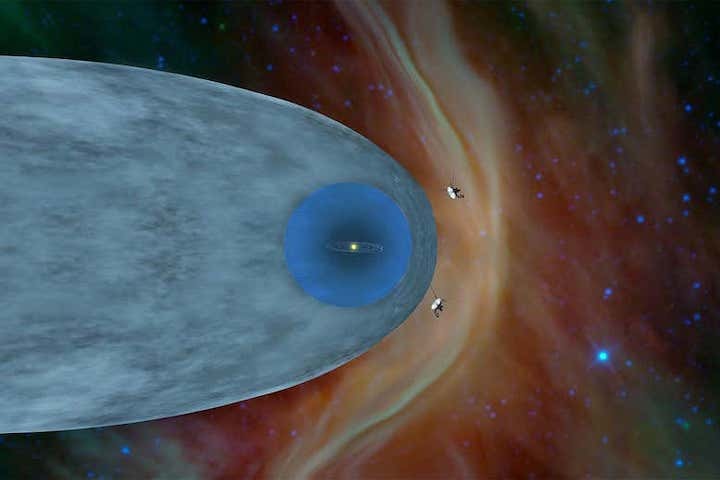
NASA/JPL-Caltech
Voyager 2 has sent back its first data from interstellar space. The spacecraft, launched in 1977 to study the outer planets of our solar system, passed Neptune in 1989 and then hurtled onwards to the edge of our solar system. It was declared to have exited the solar system in 2018, and has now sent back some of its first measurements from beyond.
The official edge of the solar system is called the heliopause. This is where particles blown out by the sun in the solar wind give way to the interstellar medium that permeates the entire galaxy. Voyager 2 is only the second spacecraft to have crossed the heliopause, after Voyager 1 left the solar system in 2012.
Now that researchers have analysed data from Voyager 2’s crossing, they have spotted a few differences between its measurements of the heliopause and the surrounding region and those from its predecessor. One is that Voyager 2’s crossing seemed to be smoother due to a thinner heliopause on its path.
The probe also sent measurements from just beyond the heliopause. “Material from the solar bubble was leaking out into the galaxy at distances up to…170 million kilometres, and that was very different than what happened with Voyager 1, where barely any material was leaking out,” said Stamatios Krimigis at Johns Hopkins University in Maryland during a press conference. In fact, Voyager 1 actually saw material leaking into the galaxy from the interstellar medium.
One scientific instrument on Voyager 1 that measured the surrounding plasma – a form of matter in which a gas loses its electrons – was broken by the time the craft passed the heliopause, so Voyager 2 was able to look at some things that Voyager 1 could not. That included a layer inside the heliopause where the plasma seemed to pile up and get very dense, as well as a layer between the heliopause and interstellar space where the plasma from the two areas was mixed.
The heliopause remains largely mysterious despite the information from the Voyager missions: we don’t know its exact shape or structure, partially because both spacecraft left the solar system travelling in approximately the same direction. “Here’s an entire bubble that we’ve only crossed at two points,” said Krimigis. “Two examples are not enough.”
The spacecraft could still send back more data. Both are still functioning and taking measurements in interstellar space, but they will probably run out of power in the next five years or so. No further missions to interstellar space are currently planned.
Quelle: NewScientist
+++
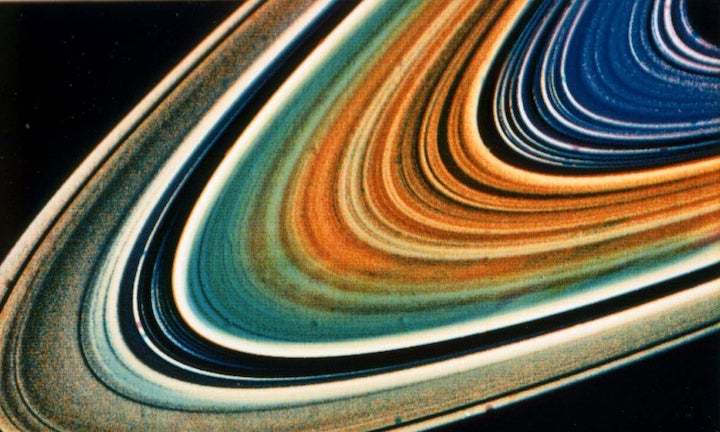
Voyager 2: the story of its mission so far – in pictures
Possible variations in chemical composition from one part of Saturn’s ring system to another are visible in this Voyager 2 picture. Photograph: NasaSince launching in 1977, the Nasa probe has captured never-before-seen images of the solar system
-
An illustration from 1965 shows the calculated trajectories of Voyager 1 and Voyager 2. Launched 16 days apart, the two probes were designed to take advantage of a rare alignment of the outer planets that occurs once every 176 years. Their trajectories have taken them by the outer planets, where they have captured never-before-seen images. Jupiter and Saturn gave them a ‘gravity assist’, boosting their velocity. Though both spacecraft were destined for interstellar space, they followed slightly different trajectories
Photograph: JPL-Caltech/Nasa
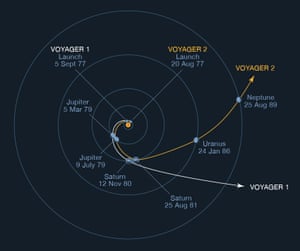
-
In 1973, the mission was named Mariner Jupiter-Saturn 1977 and was intended to go only as far as Jupiter and Saturn, as seen in the old mission logo. In March 1977 the mission name was changed to Voyager. In October 1978, a fact sheet mentioned the possibility of sending Voyager 2 to Uranus and Neptune. Voyager engineers had (unofficially) designed and built the spacecraft to be capable of navigating to Uranus and Neptune. Onboard computers were reprogrammed during the voyage, giving the spacecraft the ability to successfully return many more images and much more information than was expectedPhotograph: Nasa
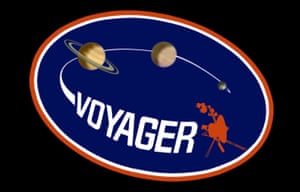
-
Engineers seen working on Voyager 2 on 23 March 1977. The probe is managed by Nasa’s jet propulsion laboratory near Pasadena, California, a division of the California Institute of TechnologyPhotograph: JPL-Caltech/Nasa
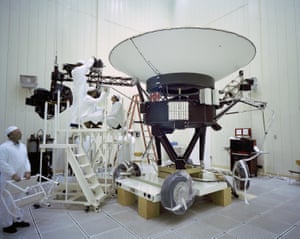
-
As the two Voyagers travel into deep space, they carry a small US flag and a golden record packed with pictures and sounds – mementoes of Earth. This picture shows John Casani, the Voyager project manager in August 1977, holding a small flag that was folded and sewed into the Voyagers’ thermal blankets before launchPhotograph: JPL-Caltech/Nasa
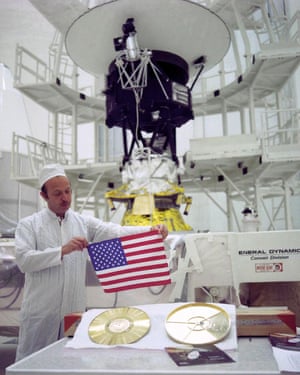 Pioneers 10 and 11, which preceded Voyager, both carried small metal plaques identifying their time and place of origin for the benefit of spacefarers that might find them. With this example before them, Nasa placed a more ambitious message aboard Voyagers 1 and 2, a kind of time capsule intended to communicate a story of our world to extraterrestrials. The Voyager message is carried by a phonograph record, a 12in gold-plated copper disk containing sounds and imagesselected to portray the diversity of life and culture on Earth. It carries extraterrestrial instructions for playing it
Pioneers 10 and 11, which preceded Voyager, both carried small metal plaques identifying their time and place of origin for the benefit of spacefarers that might find them. With this example before them, Nasa placed a more ambitious message aboard Voyagers 1 and 2, a kind of time capsule intended to communicate a story of our world to extraterrestrials. The Voyager message is carried by a phonograph record, a 12in gold-plated copper disk containing sounds and imagesselected to portray the diversity of life and culture on Earth. It carries extraterrestrial instructions for playing itPhotograph: JPL/Nasa
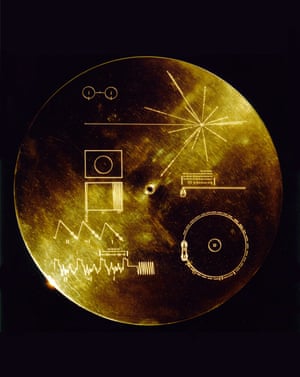
-
Voyager 2 seen in its payload fairing in August 1977, as it was hoisted upward for attachment to its launch vehicle at Nasa’s Kennedy Space Center in Cape Canaveral, FloridaPhotograph: JPL-Caltech/NASA
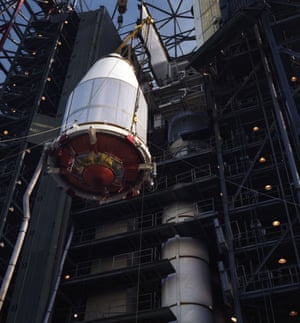
-
Voyager 2 launched on 20 August 1977, about two weeks before the 5 September launch of Voyager 1Photograph: JPL-Caltech/Nasa

-
This photograph of the southern hemisphere of Jupiter was obtained by Voyager 2 on 25 June 1979, at a distance of 8m miles (12m km). Seen in front of the turbulent clouds of the planet is Io, the innermost of the large Galilean satellites of Jupiter. Io is the size of our moonPhotograph: JPL/Nasa
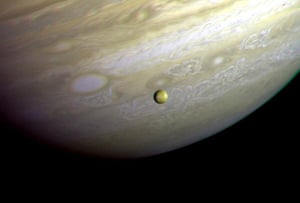 The first close look ever obtained of Jupiter’s satellite Europa was taken on 9 July 1979 as the spacecraft approached the planet. This picture was made at a range of 152,000 miles. The complicated linear features appear even more like cracks or huge fractures in these images. Also seen are somewhat darker mottled regions which appear to have a slightly pitted appearance, perhaps due to small-scale craters
The first close look ever obtained of Jupiter’s satellite Europa was taken on 9 July 1979 as the spacecraft approached the planet. This picture was made at a range of 152,000 miles. The complicated linear features appear even more like cracks or huge fractures in these images. Also seen are somewhat darker mottled regions which appear to have a slightly pitted appearance, perhaps due to small-scale cratersPhotograph: JPL/Nasa
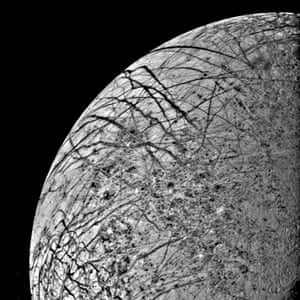
-
Voyager 2 approach Saturn in August 1981. This enhanced-colour picture shows the planet, its rings and four of its icy satellites. Three satellites (Tethys, Dione and Rhea) are visible against the darkness of space, and another smaller satellite (Mimas) is visible against Saturn’s cloud tops near the left horizon and just below the rings. This image was synthesised from images taken in Voyager’s orange, blue, and ultraviolet filters and was processed to create an exaggerated false colourPhotograph: JPL/Nasa
3628 Views
